牛津上海版八年级上册U2教案
- 格式:docx
- 大小:44.08 KB
- 文档页数:9
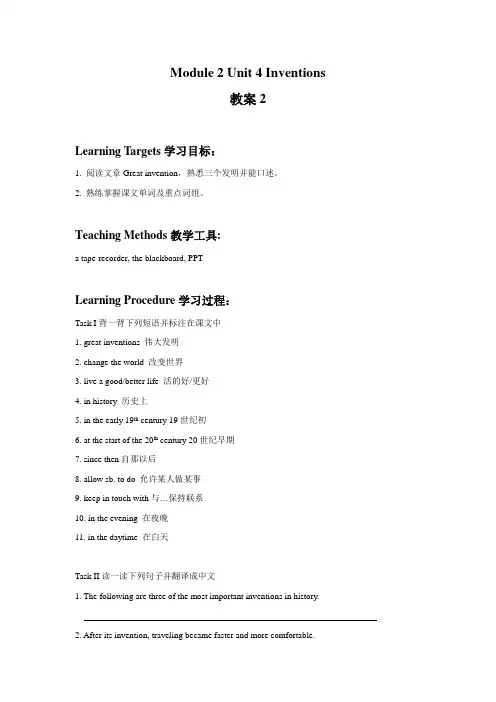
Module 2 Unit 4 Inventions教案2Learning Targets学习目标:1. 阅读文章Great invention,熟悉三个发明并能口述。
2. 熟练掌握课文单词及重点词组。
Teaching Methods教学工具:a tape-recorder, the blackboard, PPTLearning Procedure学习过程:Task I背一背下列短语并标注在课文中1. great inventions 伟大发明2. change the world 改变世界3. live a good/better life 活的好/更好4. in history 历史上5. in the early 19th century 19世纪初6. at the start of the 20th century 20世纪早期7. since then自那以后8. allow sb. to do 允许某人做某事9. keep in touch with与…保持联系10. in the evening 在夜晚11. in the daytime 在白天Task II读一读下列句子并翻译成中文1. The following are three of the most important inventions in history.2. After its invention, traveling became faster and more comfortable.3. Without the wheel, we would not have these inventions.4. Since then, people have been able to speak to each other over long distances.5. They allow people to keep in touch with each other anytime, anywhere.6. With light bulbs, people can do as many things in the evenings as they can in the daytime.Task III学一学练一练下列知识点1.invention词性_____;动词_________;名词(发明者)__________。

牛津上海版八年级上册 Unit 2 Work and play 教学设计一. 教材分析牛津上海版八年级上册Unit 2 Work and play主要讨论了学生和老师们在学习和休闲方面的活动。
本单元通过介绍不同人物的不同工作和休闲方式,让学生们学会描述自己和他人的日常活动,并在真实的语境中运用一般现在时。
二. 学情分析八年级的学生已经掌握了英语学习的一些基本知识,能够进行简单的日常交流。
他们对新鲜事物充满好奇,善于模仿和创造。
因此,在教学过程中,教师需要充分调动学生的积极性,引导他们通过观察、思考、实践和交流来掌握本节课的知识。
三. 教学目标1.知识目标:学生能够掌握表示日常活动的词汇和短语,如“work, play,read, write, watch, do, sports”等,并能够运用一般现在时描述自己和他人的日常活动。
2.能力目标:学生能够在真实语境中运用所学知识进行交流,提高听说读写的能力。
3.情感目标:学生能够认识到学习与休闲的重要性,养成良好的学习和生活习惯。
四. 教学重难点1.重点:学生能够掌握表示日常活动的词汇和短语,并运用一般现在时描述自己和他人的日常活动。
2.难点:学生能够正确运用一般现在时进行描述,并在真实语境中进行交流。
五. 教学方法采用任务型教学法、情境教学法和合作学习法。
通过设定各种真实的情境,让学生在完成任务的過程中,自然而然地学习和运用所学知识。
同时,鼓励学生积极参与,发挥团队协作的精神,提高语言实际运用能力。
六. 教学准备1.教师准备:提前准备与课程相关的情景和任务,制作PPT和教学素材。
2.学生准备:预习新课内容,了解一般现在时的基本用法。
七. 教学过程1.导入(5分钟)教师通过提问方式引导学生谈论自己和学习伙伴的日常活动,激发学生的学习兴趣。
例如:“What do you usually do in your free time?”“Do you like sports?”等。
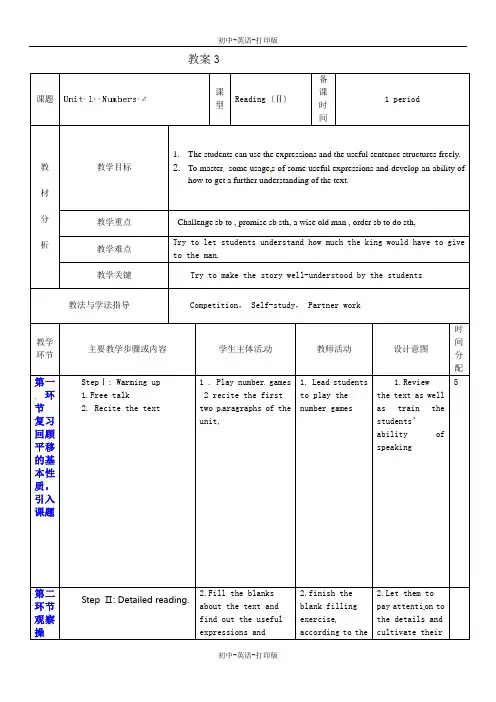
教案3课题课型Reading (Ⅱ)备课时间1 period教材分析教学目标1.The students can use the expressions and the useful sentence structures freely.2.To master some usage s of some useful expressions and develop an ability ofhow to get a further understanding of the text.教学重点Challenge sb to , promise sb sth, a wise old man , order sb to do sth,教学难点Try to let students understand how much the king would have to giveto the man.教学关键Try to make the story well-understood by the students教法与学法指导Competition, Self-study, Partner work教学环节主要教学步骤或内容学生主体活动教师活动设计意图时间分配第一环节复习回顾平移的基本性质,引入课题StepⅠ: Warming up1.Free talk2. Recite the text1 . Play number games2 recite the firsttwo p aragraphs of theunit,1. Lead studentsto play thenumber games1.Reviewthe text as wellas train thestudents’ability ofspeaking5第二环节观察操Step Ⅱ: Detailed reading. 2.Fill the blanksabout the text andfind out the usefulexpressions and2.finish theblank fillingexerciseaccording to the2.Let them topay attenti on tothe details andcultivate their作、探索归纳平移的作法StepⅢ:Important phrases and Sentence structureslearning. structures in the textlike :India , wise, prize,grain , double , collect,realized, square3. Make sentences withthese importantpoints in the text andtake notes of theexplanati ons of theimportant points:challenge him to a game,order his men to ,realize the problem ,have enough rice to ,a long time ago , andso on , copy downtext , and missthe importantphrases anddifficult pointin the blankfillingexercise3. Show somepictures by PPT,and expl ain theusage of theimportantphrases and themain lan guagepoints ,thebasicstructures ofthe text. Thenprepare severalpaper whichcontain thesentence madewith theimportantphrasesability ofthinking.3.To develop thestudents’ability ofcooperation andto make everysu re studenttake part in thework.第三环节课堂练习StepVI: Mor e practice 4. Use the right formsof the expressions tofinish the sentences.5. Translate theChinese sentencesinto English by usingthe important phrasesin the text4.Give them anexample to dothe exercise.5. work in groupto check theanswers.4. to consolatethe usage of thekey points ofthe text5. let studentsuse the usefulexpressionsthey learned第四环节课时小结StepⅥ: sum up7.write down andremember theimportant points ofthis class.6.Show a PPT andsum up the mainpoints of thetext and leadstudents to readit.第五环节课后作业Step V: Homework 1. remember theimportant points andprepare for thedictation2. Make sentences withthe important pointsand structureslearned in this class课堂教学流程Free talk→ Reciting→ Get the important points and play games →Useful-structure→ Exercise。
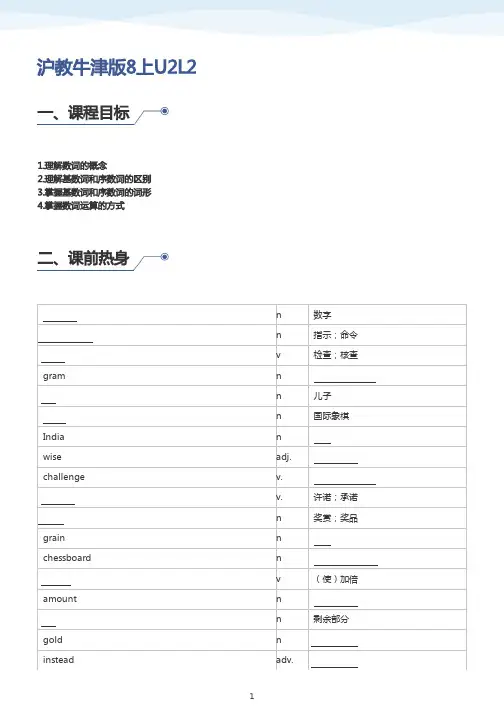
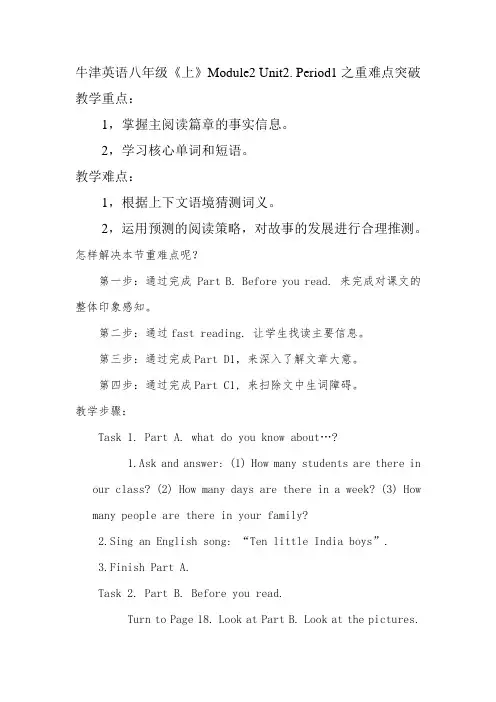
牛津英语八年级《上》Module2 Unit2. Period1之重难点突破教学重点:1,掌握主阅读篇章的事实信息。
2,学习核心单词和短语。
教学难点:1,根据上下文语境猜测词义。
2,运用预测的阅读策略,对故事的发展进行合理推测。
怎样解决本节重难点呢?第一步:通过完成 Part B. Before you read. 来完成对课文的整体印象感知。
第二步:通过fast reading. 让学生找读主要信息。
第三步:通过完成Part D1,来深入了解文章大意。
第四步:通过完成Part C1, 来扫除文中生词障碍。
教学步骤:Task 1. Part A. what do you know about…?1.Ask and answer: (1) How many students are there inour class? (2) How many days are there in a week? (3) How many people are there in your family?2.Sing an English song: “Ten little India boys”.3.Finish Part A.Task 2. Part B. Before you read.Turn to Page 18. Look at Part B. Look at the pictures.the article of the story and the first sentences of paragraphs 1 and 2 on Page 19. Then circle the correct andswers.Task 3. Fast reading. and finish this gram.Who: . .When: .Where: .What: .Task 4: Part D1. read the story on Page 19 and complete the table.Task 5. Part C1. The words in italics are from the story on Page 19. Match the two halves of these sentences to make them meaningful.Task 6. Listen to the tape and read the story aloud.Summary: Today we have learnt a story about the nubers. and some words.Blackboard writing:1.a long time ago = once upon a time.2.challenge sb to sth.3.order sb to do sth.Homework: 1. To recite the new words.2. To read aloud this story.。
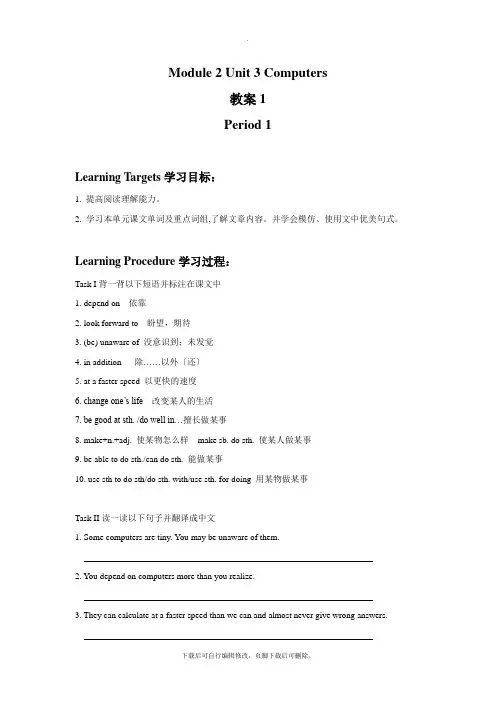
Module 2 Unit 3 Computers教案1Period 1Learning Targets学习目标:1. 提高阅读理解能力。
2. 学习本单元课文单词及重点词组,了解文章内容。
并学会模仿、使用文中优美句式。
Learning Procedure学习过程:Task I背一背以下短语并标注在课文中1. depend on 依靠2. look forward to 盼望,期待3. (be) unaware of 没意识到;未发觉4. in addition 除……以外〔还〕5. at a faster speed 以更快的速度6. change one’s life 改变某人的生活7. be good at sth. /do well in…擅长做某事8. make+n.+adj. 使某物怎么样make sb. do sth. 使某人做某事9. be able to do sth./can do sth. 能做某事10. use sth to do sth/do sth. with/use sth. for doing 用某物做某事Task II读一读以下句子并翻译成中文1. Some computers are tiny. You may be unaware of them.2. You depend on computers more than you realize.3. They can calculate at a faster speed than we can and almost never give wrong answers.4. In addition, computers can do important jobs like operating railways and flying planes and spaceships.5. Your brain can produce new ideas but computers cannot.6. However, one day computers may be able to do a better job than human beings.7. What will happen to us if computers can do all our jobs?8. Computers changed our lives, but will they make them better?___________________________________________________________________Task III学一学练一练以下知识点1. depend 词性_____; 形容词_________; 名词__________ ;反义词_________【搭配】依靠,依赖于__________(动词短语)_______________(形容词短语)不要依赖父母,我们应该学着独立。
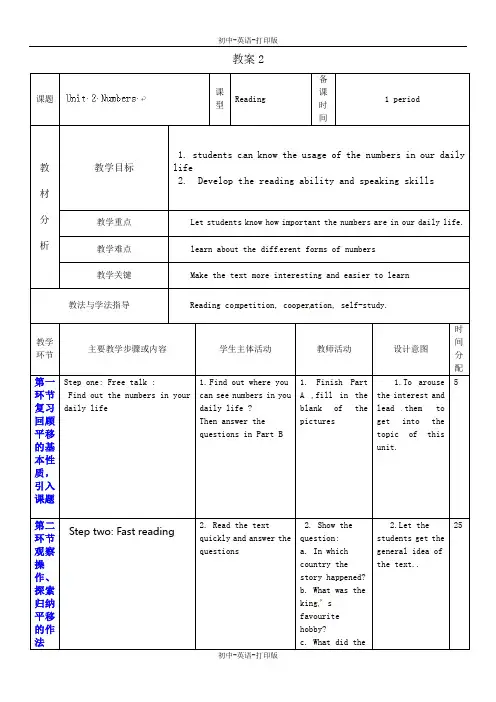
教案2课题课型Reading备课时间1 period教材分析教学目标1. students can know the usage of the numbers in our dailylife2. Develop the reading ability and speaking skills教学重点Let students know how important the numbers are in our daily life.教学难点learn about the diff erent forms of numbers教学关键Make the text more interesting and easier to learn教法与学法指导Reading co mpetition, cooperation, self-study.教学环节主要教学步骤或内容学生主体活动教师活动设计意图时间分配第一环节复习回顾平移的基本性质,引入课题Step one: Free talk :Find out the numbers in yourdaily life1.Find out where youcan see numbers in youdaily life ?Then answer thequestions in Part B1. Finish PartA ,fill in theblank of thepictures1.To arousethe interest andlead them toget into thetopic of thisunit.5第二环节观察操作、探索归纳平移的作法Step two: Fast reading 2. Read the textquickly and answer thequestions2. Show thequestion:a. In whichcountry thestory happened?b. What was theking’sfavouritehobby?c. What did the2.Let thestudents get thegeneral idea ofthe text..25Step three: while-reading. Reading comprehension. 3. Read the text indetails and finish theblank fillingexercise in a sheet,then check theanswers ,after that ,try to designquestions accordingto the text and askyour classmates toanswer it .Then let students havea try to count how muchrice the man couldget?4. Talk in group : Canyou tell someinteresting storiesabout numbersman want if hewon the game?d.Who win thegame?e. How much ricedid the man winat last?3. hand out thesheet and designthe blankaccording to theimportantinformation.Then check theanswers withstudents4. share someinterestingstories aboutnumb ers withstudents3.To make themget familiarwith the detailsof the text andtrain theirability ofreading4.train thestudentsspeakingability andcooperationability.Step four: Discussion第三环节课堂练习Step five: exercise 5.Finish theexercise i n Part Cand D5.Help them tofind the detailsin the text.5. To train thestudents’readingability .5第四环节课时小结step Six: Sum up 6 Sum up :Numbers arevery important in ourdaily life. We shoulduse it carefully .6. Show a PPT tosum up : numberscan be used toshow time, tell usthe amount ofthings , and canindentify therooms etc.6. Prepare forthe writing5第五环节课后作业 Homework 1. Read the textfluently2. write a passageabout the usage ofnumbers in our dailylifeHand out asheet whichcontain therequest ofwriting thepassageStrengthen thecomprehensionof the text.课堂教学流程Free talk --- Preparation ---Reading competition ----- Discussion—exercise—sum up--Homework .效果评价与反思。
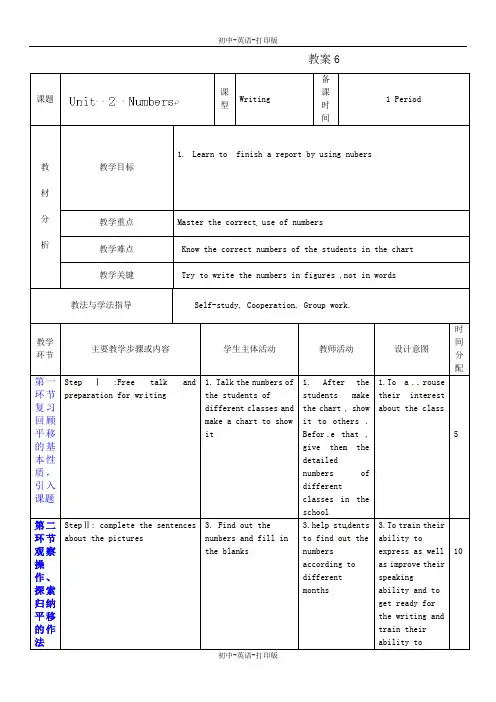
教案6课题课型Writing备课时间1 Period教材分析教学目标1.Learn to finish a report by using nubers教学重点Master the correct use of numbers教学难点 Know the correct numbers of the students in the chart 教学关键 Try to write the numbers in figures ,not in words教法与学法指导Self-study, Cooperation, Group work.教学环节主要教学步骤或内容学生主体活动教师活动设计意图时间分配第一环节复习回顾平移的基本性质,引入课题StepⅠ:Free talk andpreparation for wr iting1. Talk the numbers ofthe students ofdifferent classes andmake a chart to showit1. After thestudents makethe chart , showit to others .Befor e that ,give them thedetailednumbers ofdifferentclasses in theschool1.To a rousetheir interestabout the class5第二环节观察操作、探索归纳平移的作法StepⅡ: complete the sentencesabout the pictures3. Find out thenumbers and fill inthe blanks3.help stu dentsto find out thenumbersaccording todifferentmonths3.To train theirability toexpress as wellas improve theirspeakingability and toget ready forthe writing andtrain theirability to10cooperate.第三环节课堂练习Step III: WritingStep IV: Check the passage 4.Before writing ,find out the numbersaccording to theyears, and begin towrite the passage ,pay attention to thetenses4.Show thenumbers and thematched yearson PPT, thenremindstudents to payattention totheirhandwritingand check them istakesstudents make4.To train thestudents’writing ability.15第四环节课时小结Step five Sum upHow to organize the writing.5. Sum up the usage ofnumbers in our dailylife.5.List thebeautifulsentences theywrite in thepassages5.Let them getfamiliar withthe writ ing.5第五环节课后作业1. Recite the passage which given as a sample .课堂教Free talk and preparation →Fill in the blank →write a pa ssage—Check the writhing. 学流程效果评价与反思。
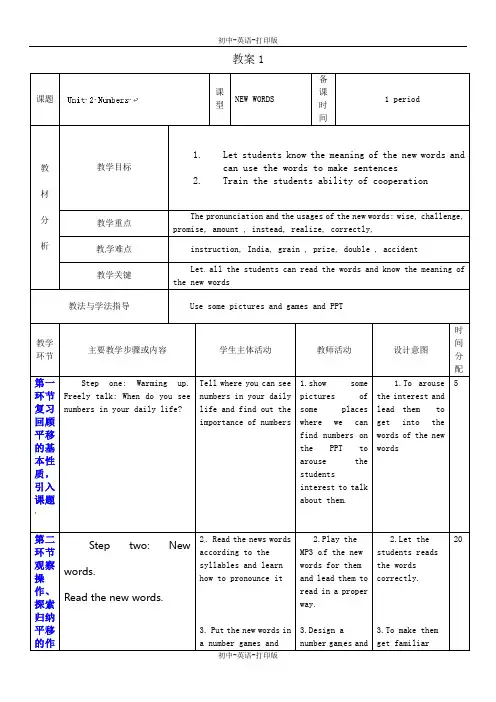
教案1课题课型NEW WORDS备课时间1 period教材分析教学目标1.Let students know the meaning of the new words andcan use the words to make sentences2.Train the students ability of cooperation教学重点The pronunciation and the usages of the new words: wise, challenge,promise, amount , instead, realize, correctly,教学难点instruction, India, grain , prize, double , accident教学关键Let all the students can read the words and know the meaning ofthe new words教法与学法指导Use some pictures and games and PPT教学环节主要教学步骤或内容学生主体活动教师活动设计意图时间分配第一环节复习回顾平移的基本性质,引入课题Step one: Warming up.Freely talk: When do you seenumbers in your daily life?Tell where you can seenumbers in your dailylife and find out theimportance of numbers1.show somepictures ofsome placeswhere we canfind numbers onthe PPT toarouse thestudentsinterest to talkabout them.1.To arousethe interest andlead them toget into thewords of the newwords5第二环节观察操作、探索归纳平移的作Step two: Newwords.Read the new words.2. Read the news wordsaccording to thesyllables and learnhow to pronounce it3. Put the new words ina number games and2.Play theMP3 o f the newwords for themand lead them toread in a properway.3.Design anumber gam es and2.Let thestudents readsthe wordscorrectly.3.To make themget familiar20法Step three: Play numbergames to remember thenew wordsStep four: Key wordslearning. play games .try to remember thenew words as quicklyas you can, with thehelp of the groupleader, then checkwith each otherwhether you rememberthe words or not .4. Work in groups tolearn the usage of thekey words, helpful ,anywhere, finally,nothing , arrive at,lead sb to , fallasleep , get down, byoneself, wake up5. match the new wordsand the pictu res shownon the pptplay a numbergames to helpthe studentswhen they havetrouble inreading the newwords4.Show the PPTof the meaningof th e key wordsand let ss makemore sentenceswith th e newwords5. check the wordsand give themmarks for thegroupswith thepronunciationand the spellin gof the newwords.4. Train thestudents’ability tocooperate. Letthe students indifferent levescan take part inthe activity.5.Provie thechances tostudents to showthemselves andpractice thespeakingability.Step five: have a competition第三环节课堂练习Step six: exercise1. use the correct forms ofthe words to fil l in theblanks like :My mother doesn’t allow me____( go) out at night.6. Finish theexercise given onthe sheet.6.Collect themistakes in thestudents’exercise.6. to consulatethe usages ofthe new words10第四环节课时小结step SevenHow many words do youmaster?Write them down in yoursheet7. Remember the wordsyou learn and spellthem out7.Give them apiece of paperto write thewords.7.To de velop thestudents’ability of self–checking.5。
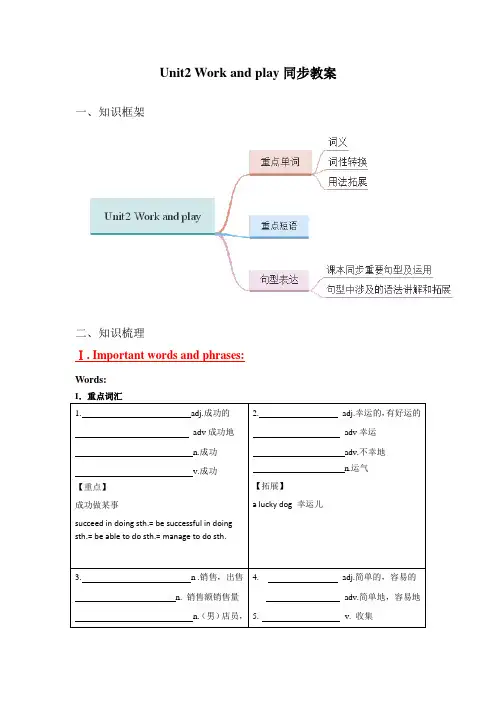
Unit2 Work and play同步教案一、知识框架二、知识梳理Ⅰ. Important words and phrases:Words:1. adj.成功的adv成功地n.成功v.成功【重点】成功做某事succeed in doing sth.= be successful in doing sth.= be able to do sth.= manage to do sth. 2. adj.幸运的,有好运的adv幸运adv.不幸地n.运气【拓展】a lucky dog 幸运儿3. n .销售,出售n. 销售额销售量n.(男)店员,4. adj.简单的,容易的adv.简单地,容易地5.v. 收集Ⅱ.重点词汇拓展12. drive v.驾驶;驱使drive sb. to sp. 开车送某人去某地drive sb. to do sth. 驱使某人去某地13.attend, join, join in, take part in辨析attend+会议attend the meeting/ classjoin+个人/团体join us, join the Party入党join in/ take part in+活动join in/ take part in activities 14.similar adj.相似的A be similar toB A和B相似A andB are similar inC A和B在C方面相似【形近词】familiar adj.熟悉的sb. be familiar with sth. 某人对某物熟悉的sth. be familiar to sb. 某物对于某人而言是熟悉的15.expect v.期待expect sth. expect (sb.) to do sth. 期待(某人)做某事look forward to doing sth. 期待做某事expectation n.期待16.popular adj.流行的be popular with/ among 在……中是流行的17.continue v.继续continue to do sth. 继续做某事(另一件事)continue doing sth. 继续做某事(原来的事)carry on= go on= continue 继续18.explain v.解释explain sth. to sb.向某人解释某事explanation cn.解释make an explanation to sb. 给某人一个解释19.energy n. 能量energetic adj.精力充沛的power n.权力powerful adj.强大的resource n.资源20.force n.(物理)力v. 强迫force sb. to do sth. 强迫某人做某事21.heat n.热,热度v. 加热【课堂小练】Ⅰ. 用所给单词的适当形式填空(错误率:掌握情况:)1. The bank refuses to accept _______________ for the mistake. (responsible)2. They were proud of their children’s _______________. (achieve)3. The children quickly got _______________ with staying indoors. (boring)4. It is _______________ to start a speech by thanking everybody for coming. (usually)5. Tom was still on his way to school, because he ______________ to catch the first bus. (failure)6. Tickets are on _______________ from the booking office. (sale)7. She is very clever and often do well in her _______________. (exam)8. The teacher _______________ the answers on the board yesterday. (write)Phrases:1. ride a motorcycle 骑摩托车2. play the piano 弹钢琴3. one of the top students in the city 市里优秀生之一4. have written several successful computer games已经写了几个成功的电脑游戏5. the manager of the company 公司的经理6. be responsible for sales 负责销售7. make phone calls to our clients on the way 在路上打电话给我们的客户8. some boring work 一些无聊的工作9. achieve A grades in all my subjects 各门学科都得A10. discuss the business over breakfast 早餐期间讨论公司业务11. fail an exam 考试不及格12. collect me from school 到学校接我13. attend Computer Club meetings 出席电脑俱乐部会议14. ask me to assist them 请我帮助他们15. continue doing sth. 继续做某事16. It is time for lessons. 上课的时间到了。
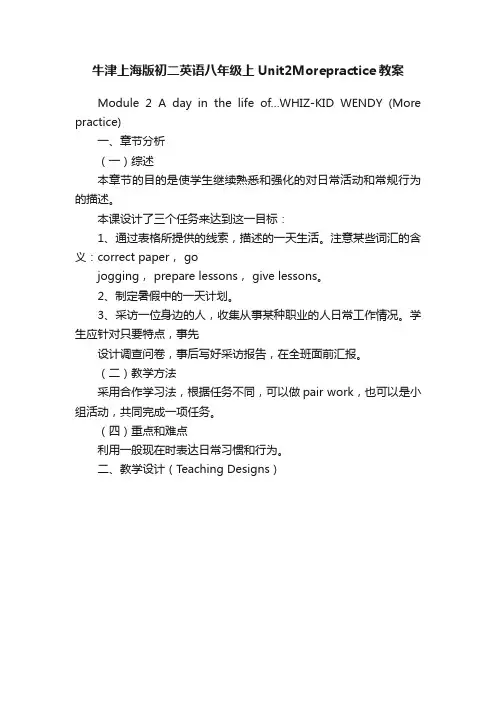
牛津上海版初二英语八年级上Unit2Morepractice教案Module 2 A day in the life of…WHIZ-KID WENDY (More practice)一、章节分析(一)综述本章节的目的是使学生继续熟悉和强化的对日常活动和常规行为的描述。
本课设计了三个任务来达到这一目标:1、通过表格所提供的线索,描述的一天生活。
注意某些词汇的含义:correct paper, gojogging, prepare lessons, give lessons。
2、制定暑假中的一天计划。
3、采访一位身边的人,收集从事某种职业的人日常工作情况。
学生应针对只要特点,事先设计调查问卷,事后写好采访报告,在全班面前汇报。
(二)教学方法采用合作学习法,根据任务不同,可以做pair work,也可以是小组活动,共同完成一项任务。
(四)重点和难点利用一般现在时表达日常习惯和行为。
二、教学设计(T eaching Designs)1. What is your job?2. What time do you get up every day?3. When do you go to work every day?4. How do you go to work?5. What do you do at work?6. What do you do in your spare time?7. How often do you take sports?8. How long do you watch TV every week?9. Do you like music?Why?10. Do you love your job?Why。
教案4课题课型Listening andSpeaking备课时间1 period教材分析教学目标1. Let students know how to read the number in different ways.2. improve their listening and speaking skills教学难点To catch the missing words when liste ning教学关键Learn to take note quickly when listening教法与学法指导Group work. Self—study教学环节主要教学步骤或内容学生主体活动教师活动设计意图时间分配第二环节观察操作、探索归纳平移的作法Step I: Prepare for thelistening and speakingSte p II: Do the listeningStepⅢ.Speaking1. know the meaning ofthe following words :Zero, point , percent,Amazing2.Read the numbers inPart A and finish thequiz aboutnumbers .Then do thelistening in thesecond part of part A3. Read the strong andweak forms of thewords .Then listen tothe dialogue andpractice the dialoguein pairs. Then find1.Revie w thenumbers2. le ad studentsto read thenumbers andfinish the quizplay thelisteningmaterials , stopwhen neces saryAnd then checkthe answers3. Play therecord and letstudents listento the dialogueand practice thedialogue in1.To move theobstacles of thelistening andspeaking2.To train thestudents’ability ofcatching theinformation ofthe li steningmaterials .3.To develop thestudents’ability oflistening andspeaking.out the mistakes forJoyce and practice the telephone dialoguepairs.第三环节课堂练习Step IV :Make notes aboutthe listening.4.Write down the keywords you get in thelistening part.4.Tell them tofind the keywords.4.To help thestudentsdevelop someways oflistening.第四环节课时小结StepⅥ Sum up 6.Know how to takenote s when doing th elistening and know howto read a numbercorrectlye ppt tohelp them sum up6.Help them tocultivate theability ofsummarizing.第五环节课后作业 Make a dialogue with some numbers when you shopping in the mall课堂教Prepare for listen ing → Listening →Speaking→summa ry 学流程效果评价与反思。
Ⅰ.Key phrases.1. a long time ago 很早以前2. challenge…to 向(某人)挑战3.and so on 等等4. from then on 从那时起5. take place 发生6. nothing but 只不过;只有7. develop into. 发展成.. 8. lead to 导致…9.traffic accident 车祸10. so that 为了…II. Reading1. a number of the number of ...的数量A number of students in the classroom.200.2. India (n.)印度;(adj.)印度的(n.) 印度人The girl comes from3. Wouldn’t you like gold or silver instead?难道你不喜欢黄金或白银?※Instead的意思是“代替”,常与of连用接名词或代词。
Will you go to the party me?4. … and then double the amount for each of the rest of the squares.……然后,把方格中剩余部分的每一格都增加到前一格的两倍。
※rest作名词,意为“其余;剩余部分”,常与定冠词the连用,有时它的后面也可以跟of 短语。
如:拿走你想要的,丢掉剩下的。
留些食物给我们其余的人。
※promise也可以作名词,常用于短语make a promise“ 许诺” ,keep a promise“遵守诺言” ,break a promise“违背诺言”等。
如:He’ll lose face if he does not 如果他不信守诺言,就会丢脸。
I’m sorry that I broke my promise. 对不起,我食言了。
III. Grammar:一、基数词与序数词★基数词表示数量的多少,常用来谈论数目、时间等,如:eleven miles, nine o’clock等。
Module 2 Unit 3 Computers教案2Period 2Learning Targets学习目标:学习掌握形容词比拟级和最高级Learning Procedure学习过程:ⅠLearning Strategies1. Self-study2. CooperationⅡLearning Preparation1. Daily sentences: All roads lead to Rome. 条条大路通罗马。
2. Daily reading:A: Hello, Peter, I’ve got some good__________. B: What’s it?A: A foreign lady will teach us English next term.B: Where does she come_____________?A: Canada. It’s _________that she is an excellent teacher.B: Wonderful! I ________ we can make great progress(进步) in English. A: I think so. We can _________ speaking English with her in our free time. B: That sounds good!ⅢLearning ProceduresSelf-observationThe comparative of adjectives & The superlative of adjectives形容词的比拟级&形容词的最高级We use the comparative of adjectives when we compare two things.We use the superlative of adjectives when we compare more than two people or thingsActivity 1: Work out rules about cardinal numbers. 看以下形容词的比拟级,找规律。
1、阅读教材P282、写出下列单词和词组的汉语意思:traffic accident_____________ draw a line graph_____________go up___________ rise _____________ go down___________ fall_____________ write a report__________1、预习反馈:2、出示学习目标:3、探究点一:(1)学生观察练习A的曲线图,回答以下问题。
What’s the line graph about?What does the vertical axis stand for?What does the horizontal axis stand for?How many accidents were there in July?What’s the number of accidents in August?探究点二:1.学生再次观察曲线图,完成下列练习。
The number of accidents (went up/went down)in October.The number of accidents (went up/went down)in October。
探究点三:看以下例句,请学生找出句子中的近义词。
The price of rice went up in March and it rose again in April.The population of the city went down in 2011 and it fell again in 2012.探究点四:学生完成练习A 。
一完成28页Writing B部分写一篇反映某地初中在校注册人数变化的报告。
(小组合作,小组互换作文,不同组同号同学进行批改,教师选择有代表性文章进行点评)___________________________________________________________________________ ___________________________________________________________________________ ___________________________________________________________________________ ___________________________________________________________________________ ___________________________________________________________________________ ___________________________________________________________________________ ___________________________________________________________________________ ___________________________________________________________________________ ___________________________________________________________________________ ___________________________________________________________________________ ___________________________________________________________________________ ___________________________二请以Numbers are __________________ in our daily lives为题写一篇短文。
Unit2 Intergrated lesson for numbers (worksheet) Objectives: 1. Be able to read and identify(区分) numbers .2. Know how to make some predictions(猜测) and find key wordsfor numbers before listening3.Can write numbers in figures through line graph.4. Be able to use the numbers to express ideas.Task 1: Listening for numbersListen to the tape and fill in the blanks .Task 2 : Talk time ---- Giving yourself time to thinkThink about the money you need each month for these things:sth cost sb…. It takes sb …to do.. sb need…for..Task 3 :Complete a report with numbersThis is a line graph about the dropouts (失学儿童)) in Guangdong province.Numbers of dropouts (2009—2012 )The graph shows that there were (1) dropouts in our province in 2009. In (2) , the number(3) fell to (4) and then(5) rose to (6)In (7) . In (8) , the number (9) again to (10) . Task 4 : Do a survey on your classmateSurvey on your classmate and see how much he can save each month.Task 5: Write down the survey about your classmate .He was deeply affected by what he saw on the dropouts in mountains . Although he doesn’t make any money , he really wants to save some money to help the poor children.He usually spends a monthon andNow ,he will tryIf . Al together, he can savein total . He hopesLet’s start out small !Self-examination : put a tick on your choice !Homework1.Write as many numbers as possible.基数词99 _____________ 148 ____________ 201_______________379 ______________ 1,010 ___________ 258,000 _____________ 1,000,000 124,000,000440,000,000,000 25,000,000,000表达时刻8:21 8:56 8:306:15 6:00表达日期和年龄1900 1908 2010 年5月13日在20世纪90年代在七岁时一个七岁的女孩表达编号第8号第109页第9行第418房间14路公共汽车第5大街电话号码84525744邮政号码510320序数词第18 第19 第88第20 第50 第100 表达分数1/2 1/3 2/3 3/4 2/5。
牛津上海版英语八年级上册《Unit 2 Work and play》说课稿1一. 教材分析《牛津上海版英语八年级上册》的Unit 2 Work and play主要介绍了关于工作和娱乐的话题。
本单元通过不同职业和活动,让学生了解和掌握相关词汇和表达方式,并培养他们的听说读写技能。
教材内容丰富,贴近学生生活,能激发学生的学习兴趣。
二. 学情分析八年级的学生已经具备了一定的英语基础,对于日常生活中的词汇和简单句型已能熟练运用。
但部分学生对较为复杂的语法结构和较生僻的词汇掌握不够扎实,需要加强训练。
此外,学生对英语学习的兴趣和积极性较高,但部分学生存在一定的焦虑情绪,害怕犯错。
三. 说教学目标1.知识目标:学生能掌握本课的生词、短语和句型,了解不同职业和娱乐活动。
2.能力目标:学生能用英语进行简单的交流,提高听说读写技能。
3.情感目标:培养学生对不同职业的尊重和理解,激发他们学习英语的兴趣。
四. 说教学重难点1.重点:本课的生词、短语和句型。
2.难点:对不同职业和娱乐活动的表达方式,以及如何在实际情景中运用。
五. 说教学方法与手段1.任务型教学法:通过设定不同任务,让学生在实际操作中运用所学知识。
2.情境教学法:创设生活情境,让学生在真实环境中学习英语。
3.互助合作学习:鼓励学生相互帮助,共同完成学习任务。
六. 说教学过程1.热身(5分钟):用歌曲或游戏引起学生对主题的兴趣,调动课堂氛围。
2.引入(10分钟):展示不同职业和娱乐活动的图片,引导学生讨论并介绍自己喜欢的职业和活动。
3.新课呈现(15分钟):讲解生词、短语和句型,并通过例句展示用法。
4.实践环节(15分钟):分组进行角色扮演,让学生在实际情境中运用所学知识。
5.巩固环节(10分钟):进行听力练习和口语交流,加强对知识的巩固。
6.总结(5分钟):对本课内容进行总结,强调重点和难点。
七. 说板书设计板书设计要清晰、简洁,突出本课的重点。
可以采用思维导图或形式,将职业、娱乐活动和相关词汇进行整理。